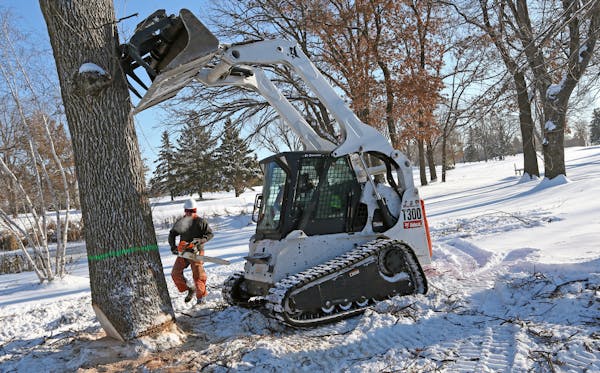The bug vs. bug strategy to defeat the emerald ash borer might just be working.
Tiny stingless wasps — the natural parasite introduced two years ago to defend Minnesota's massive ash population — are reproducing, spreading and killing ash borers along the way, the Minnesota Department of Agriculture reported Wednesday.
That makes Minnesota the second state, after Michigan, to document that adopting nature's way of slowing the ash borer might become an effective tool to stop the invasive pest that threatens the state's nearly 1 billion ash trees, and millions more in Wisconsin and Iowa.
Healthy wasp larvae were found this fall, for the first time, in trees at Great River Bluffs State Park near Winona, one of three sites in the state where they have been introduced to combat infestations. After raising the larvae to adults, researchers identified them as the offspring of the ones that had been introduced there in 2011.
"One of the great things is we found them half a mile from the nearest release site," said Monika Chandler, Biological Control Program Coordinator for the state Department of Agriculture. "That documents they are dispersing and spreading on their own."
The invasive ash borer has killed tens of millions of trees in 20 states and two Canadian provinces since it arrived from China about 20 years ago, apparently in wooden shipping crates sent to Michigan.
It was first found in Minnesota in St. Paul in May 2009, and infestations have been found in Ramsey and Hennepin counties in the metro area and Houston and Winona counties in the state's southeast corner. Ash borers have also been found in Superior, Wis., raising concerns about its spread to Duluth and the state's northeastern forests, where black ash is a dominant species.
The wasps, developed at a U.S. Department of Agriculture facility in Brighton, Mich., have now been deployed in 17 states. In Minnesota, they've been released at three sites in the metropolitan area and far southeast Minnesota.
The female wasps are able to "hear" ash borer larvae under the bark of a tree. They then bore into the larvae and lay their eggs there. As the eggs develop into adults, they nourish themselves on the ash borer larvae, killing them.
In Michigan, the first state to use stingless wasps, they have been spreading steadily on their own, and now kill about 25 percent of the larvae in trees researchers have sampled. In China, where the wasps and ash borers live in a natural balance, the figure is about 70 percent.
Many tools
But proof of reproduction is only the first step to figuring out if, how and where the wasps can be a deterrent, Chandler said.
"We are operating with really big unknowns," she said. "We don't know what rate would be sufficient for control. We don't know [what] rate will be achieved."
Introducing the wasps to a site can be expensive: The one-eighth-inch tiny black bugs cost $4 apiece. Then tracking them and their larvae is extremely difficult. It requires cutting down an infested tree and peeling back the bark in areas where ash borers leave their distinctive tunnels.
"It's like looking for a needle in a haystack," Chandler said.
Nor is it clear how well either insect will tolerate Minnesota's cold winters.
Chandler said scientists believe that, like their prey, the wasps will do fine in southern Minnesota, but probably not far north in the state. But one of the concerns among forest ecologists is whether the ash borer could move north along with the warmer average temperatures that come with climate change. If so, then black ash trees are at risk.
The wasps are likely to become one of several tools to fight the invasive insect, Chandler said. Woodpeckers are effective, she added, as are some insecticides.
In addition, the state is using widely advertised restrictions on moving wood outside of areas known to be infested. To prevent the spread of the emerald ash borer during winter months, the state Agriculture Department recommends buying firewood only from locally approved vendors, and burning it in the same area where it's purchased. Quarantined areas have special restrictions on the movement of products such as ash trees, ash limbs and firewood.
Josephine Marcotty • 612-673-7394

Fired Mpls. teacher accuses management of 'cancerous rot'

Jill Biden rallies women, teachers for the Biden-Harris ticket in Bloomington speeches
Neighbors, city officials at odds over Rochester lake dam

Souhan: This is KAT's chance to prove Flip Saunders was right

